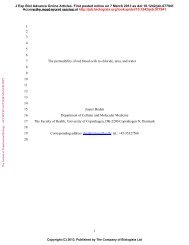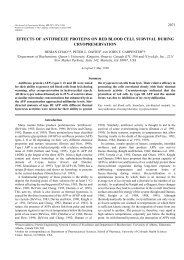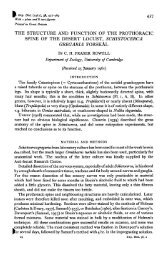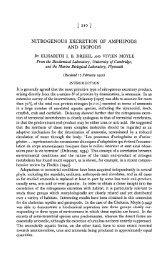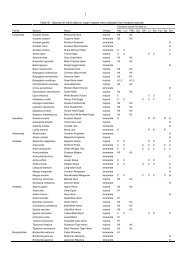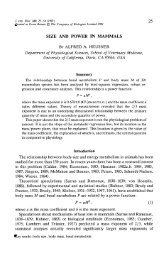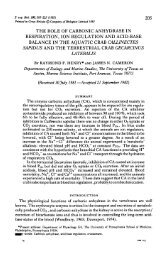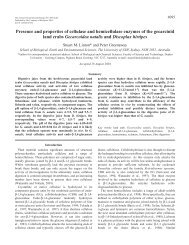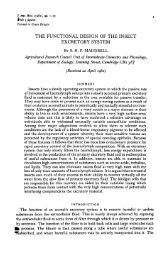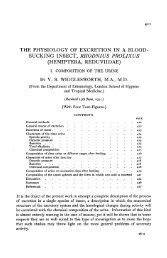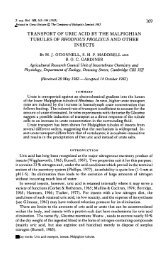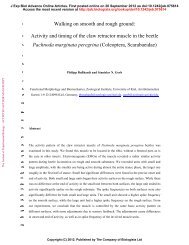the excretory system of the stick insect, dixippus morosus
the excretory system of the stick insect, dixippus morosus
the excretory system of the stick insect, dixippus morosus
Create successful ePaper yourself
Turn your PDF publications into a flip-book with our unique Google optimized e-Paper software.
The <strong>excretory</strong> <strong>system</strong> <strong>of</strong> <strong>the</strong> <strong>stick</strong> <strong>insect</strong> 185<br />
(bKnd) end <strong>the</strong> tubule is more contorted and ends at about <strong>the</strong> level <strong>of</strong> <strong>the</strong> rectal<br />
sphincter. The tubules <strong>of</strong> <strong>the</strong> nymph correspond to <strong>the</strong> superior tubules <strong>of</strong> <strong>the</strong><br />
adult.<br />
(b) The inferior tubules arise from <strong>the</strong> annulus in pairs having a very short<br />
common trunk and run at first directly backwards. The distal region <strong>of</strong> <strong>the</strong> inferior<br />
tubule, which may represent one-third or more <strong>of</strong> its total length, is in <strong>the</strong> form<br />
<strong>of</strong> a dilatation containing white granules; it is not closely applied to <strong>the</strong> gut but lies<br />
free in <strong>the</strong> posterior body cavity being attached at its blind end by short tracheal<br />
branches to <strong>the</strong> connective tissue <strong>of</strong> <strong>the</strong> fat-body. The blind end itself is provided<br />
with a cap <strong>of</strong> cells <strong>of</strong> vesicular appearance, <strong>the</strong> cells <strong>of</strong> Sirodot, between which <strong>the</strong><br />
tracheal branches pass to spread out over <strong>the</strong> distal dilatation. The only o<strong>the</strong>r<br />
tracheal supply is a single branch which applies itself to <strong>the</strong> tubule at <strong>the</strong> proximal<br />
end and runs in a loose spiral over <strong>the</strong> proximal and middle regions. There are no<br />
inferior tubules in <strong>the</strong> nymph and <strong>the</strong>y are poorly developed in <strong>the</strong> male (de<br />
Sinety).<br />
(c) The tubules <strong>of</strong> <strong>the</strong> third kind ('appendices <strong>of</strong> <strong>the</strong> midgut') open separately<br />
into small pyriform dilatations <strong>of</strong> <strong>the</strong> midgut wall anterior to <strong>the</strong> annulus. They<br />
are thinner than <strong>the</strong> superior and inferior tubules and more contorted. They run<br />
directly back to end close to <strong>the</strong> intestine about one-third <strong>of</strong> <strong>the</strong> distance from <strong>the</strong><br />
annulus to <strong>the</strong> sphincter.<br />
All three types <strong>of</strong> tubule are provided with muscular elements running in loose<br />
spirals over <strong>the</strong>ir walls and can be seen to undergo gentle writhing movements.<br />
In each <strong>of</strong> two <strong>insect</strong>s an accurate count was made <strong>of</strong> <strong>the</strong> tubules <strong>of</strong> <strong>the</strong> three<br />
types, which were found to be present in <strong>the</strong> following numbers: superior tubules<br />
24, 23; inferior tubules 134, 134; appendices <strong>of</strong> <strong>the</strong> midgut 32, 25.<br />
The appearance <strong>of</strong> <strong>the</strong> epi<strong>the</strong>lium in <strong>the</strong> different regions <strong>of</strong> <strong>the</strong> gut has been<br />
studied in sections fixed in Susa, cut at 10/x and stained in iron haematoxylin. At<br />
<strong>the</strong> region <strong>of</strong> <strong>the</strong> annulus <strong>the</strong> columnar epi<strong>the</strong>lium <strong>of</strong> <strong>the</strong> midgut gives way to <strong>the</strong><br />
cubical epi<strong>the</strong>lium <strong>of</strong> <strong>the</strong> intestine and this in turn to <strong>the</strong> tall columnar epi<strong>the</strong>lium<br />
<strong>of</strong> <strong>the</strong> six rectal glands. These epi<strong>the</strong>lia are illustrated in Fig. 2.<br />
The Malpighian tubules have been examined alive in haemolymph and are<br />
illustrated in Fig. 3.<br />
(a) Superior tubules. When observed under <strong>the</strong> low power <strong>the</strong> cells <strong>of</strong> <strong>the</strong> healthy<br />
tubule appear as a bright transparent colourless wall whose inner margin is made<br />
discernible by <strong>the</strong> presence <strong>of</strong> granules <strong>of</strong> various kinds and in varying amount. In<br />
<strong>the</strong> middle and proximal regions <strong>the</strong> granules have a greenish yellow colour, in <strong>the</strong><br />
distal region <strong>the</strong>y are white and <strong>the</strong> tip is generally devoid <strong>of</strong> granules. When <strong>the</strong><br />
<strong>insect</strong> has been feeding regularly very few granules are present, but when <strong>the</strong><br />
<strong>insect</strong> has fasted for 3 or 4 days <strong>the</strong> tubule appears to be packed with granules<br />
which, however, are not free in <strong>the</strong> lumen but are attached in masses to <strong>the</strong> inner<br />
margin <strong>of</strong> <strong>the</strong> wall. These granules are soluble in dilute alkali but not in dilute acid.<br />
An alkaline extract <strong>of</strong> <strong>the</strong> tubules <strong>of</strong> fasting <strong>insect</strong>s contains more than 20 times as<br />
much uric acid as a similar extract <strong>of</strong> <strong>the</strong> tubules <strong>of</strong> fed <strong>insect</strong>s. This suggests that<br />
<strong>the</strong>se granules contain uric acid; <strong>the</strong>y do not, however, have <strong>the</strong> appearance <strong>of</strong> <strong>the</strong>




